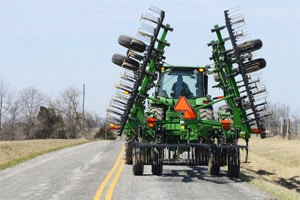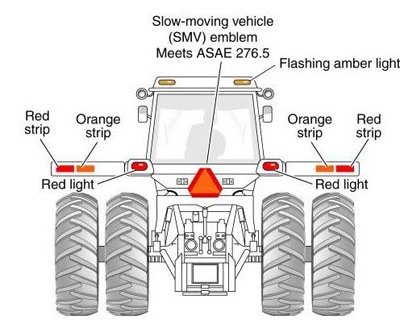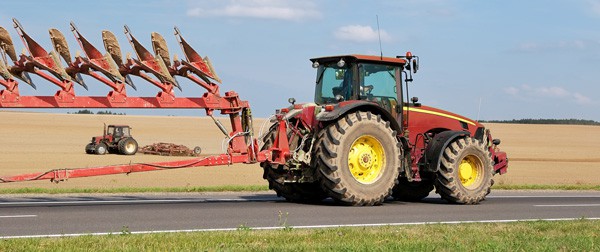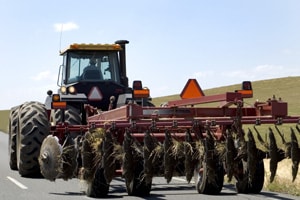MAY 2017
When machines meet the road: resources to prevent farm equipment crashes on roadways
Jenna Gibbs, PhD
Center Coordinator, Great Plains Center for Agricultural Health, Iowa City, IA
Marizen Ramirez, PhD
Principal Investigator, University of Minnesota, Minneapolis, MN
 It is important to take special precautions on the roadways during planting and harvesting season—whether you are a farmer or driver of a motor vehicle. In the Midwest region of the United States, more than 1,000 farm vehicle crashes occur each year and cause severe and fatal injuries. Most crashes (75%) result in an injury, usually with increased risk to the non-farm vehicle operator (such as a motor vehicle driver) compared to the farmer.
It is important to take special precautions on the roadways during planting and harvesting season—whether you are a farmer or driver of a motor vehicle. In the Midwest region of the United States, more than 1,000 farm vehicle crashes occur each year and cause severe and fatal injuries. Most crashes (75%) result in an injury, usually with increased risk to the non-farm vehicle operator (such as a motor vehicle driver) compared to the farmer.
The Great Plains Center for Agricultural Health recently conducted a study reporting that wider roads (wider shoulder width, for example) and increased lighting and marking on farm equipment are both associated with reduced roadway crash rates (Ramirez et al., 2016).
To promote the lighting and marking of farm equipment, from 2016-17, the Great Plains outreach team distributed more than 300 “lighting and marking kits” to farmers, along with guidelines for optimal lighting and marking of implements. During our outreach efforts, we learned that farmers with used/older farm equipment, new/beginning farmers, and farmers working on smaller, single farm properties with roads nearby were less likely to have current lighting and marking than large scale, experienced farmers with newer equipment. Beginning farmers and smaller owner/operators may be more likely to own older or used equipment models, therefore they should be careful and check this equipment to make sure it adheres to guidelines.
In the Midwest region of the United States, more than 1,000 farm vehicle crashes occur each year and cause severe and fatal injuries.
Details of the Great Plains Center study were highlighted in an April 2017 article of the Des Moines Register, discussing the harsh reality of Midwest tractor deaths on roadways in response to the farm vehicle crash involving the “Bachelor” star, Chris Soules. In addition, the study was covered by the Minneapolis Star Tribune in October 2016, which promoted the use of better lighting and reflection materials to reduce crash rates.
Below is a figure of the proper marking for a tractor, as provided by the University of Illinois Ag Safety Program.


“Lighting is a huge issue. Many times at night on rural roads I have come upon Tractors pulling ammonia tanks where no lighting is visible. If it hadn’t been for cars coming the other direction showing the outline of the tractor I would have never seen them.”
Nurse, Aplington, IA
“One time I was driving my tractor on a narrow bridge. I waited until the bridge was completely clear, and then started across. I was scared because my trailer took up half of the opposing lane. When I was almost across, a semi-truck zoomed over the hill at full speed—he wasn’t slowing down. As soon as I crossed the bridge, I pulled all the way over to the right side and into the ditch. I thought my tractor was going to roll.”
Grain Farmer, MN
“I grew up in Iowa and many times as a child and adult, passenger and driver, I was behind or passed slow moving farm vehicles. At dusk they were hard to see. I saw all kinds of situations, and sometimes saw farmers pull out right in front of oncoming traffic, just like people do in other vehicles. I was taught we had to share the road and to be careful. With the increasing inattention of drivers distracted by their devices, how on earth can people expect the statistics to go anywhere but higher?”
Rural Resident, IA

 Media coverage about this study:
Media coverage about this study: